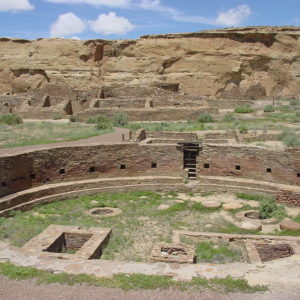Protesters in North Dakota have made headlines for months with their prolonged opposition to the construction of the Dakota Access Pipeline. The thousands of protesters include representatives from Native American tribes along with environmental activists who have joined the protest camp. It has been well documented that government officials and the pipeline company made extensive efforts to meet with tribal leaders of the Standing Rock Sioux, but those efforts were stymied by a lack of cooperation. The lack of meetings has now led to a political battle as the tribe claims they were not consulted.
Now a second controversy between a Native American tribe and a government agency wishing to discuss development options seems poised to begin, this time in New Mexico.
In late October, the U.S. Department of the Interior announced a new plan to review mineral leasing and development activity near Chaco Culture National Historical Park. Located in a remote canyon in northwestern New Mexico, the park was created to preserve one of the largest concentrations of pueblos in the southwest. This area of New Mexico also contains rich shale deposits of oil and natural gas which could be developed through fracking. Within the Department of Interior, this land is overseen by the Bureau of Land Management (BLM).
Calling the announcement “an important step forward toward addressing the longstanding concerns surrounding oil and gas development around Chaco Canyon,” Deputy Secretary of the Interior Michael L. Connor then presented a process to update the BLM’s Resource Management Plan for the area around the canyon. This guides development activities on public lands in the area, though not the park itself.
The review process was billed as a joint effort that “reflects the Department of the Interior’s emphasis on working with Native American leaders” and as part of the emphasis on local involvement, the BLM planned a series of meetings with representatives from local Navajo groups in November and early December.
Although the meetings have started, they have so far done little to relieve tensions in the area.
At the first scoping meeting, held Thursday in Shiprock, New Mexico, representatives from the BLM walked out after tribal leaders criticized the format of the meeting.
The Durango Herald reported that the BLM had set up tables for concerned community members to come forward and write down their concerns. After roughly 45 minutes, Duane “Chili” Yazzie, tribal leader and self-described “reasonable radical,” interrupted the meeting to ask for a change of format.
“[The BLM’s format] just doesn’t fit our mannerism and means of communication here as traditional people,” Yazzie said.
Richard Fields, manager of a local BLM field office explained that a meeting with open discussion fell outside of the purview of a scoping meeting.
“If you want a consultation, we’ll have to come back later,” Fields said.
After Yazzie continued to pressure for open discussion, Fields and the BLM staff left the meeting early. This does not bode well for the seven remaining planned meetings.
Yazzie and other tribal officials fear that drilling will harm an ancient astronomical area in the canyon, as well as adversely affect local health.
However, the BLM is treating the meetings as a collaborative analysis process which will allow them to mediate between both sides.
“We have uniform interest in these meetings both from [Tribal members] as well as from oil and gas producers. This, to me, is [how to] do a scoping project correctly,” said BLM Project Manager Mark Ames. In addition to the public meetings, the BLM’s plan includes a formal consultation with the Navajo Nation in December. At this point, the goal of the scoping plan is to determine how best to allow development in the area. As of yet, there are no plans to start additional drilling.

